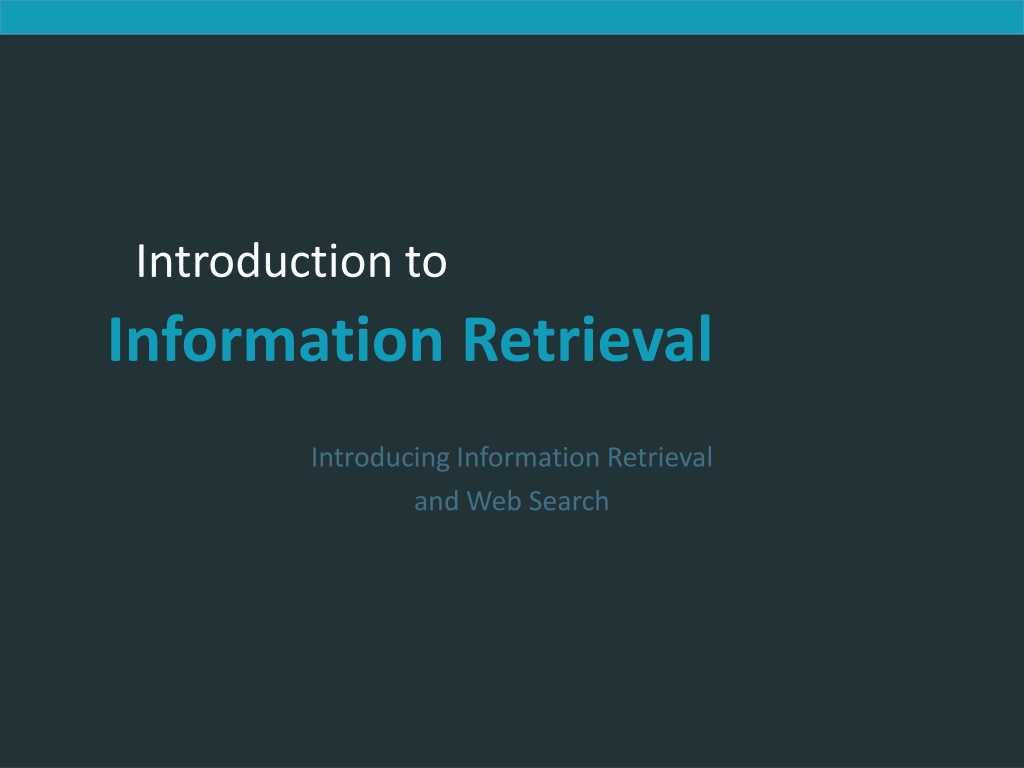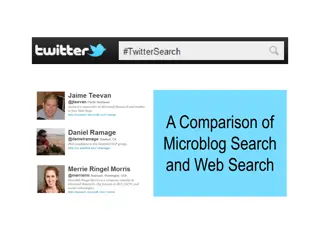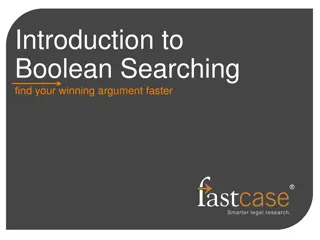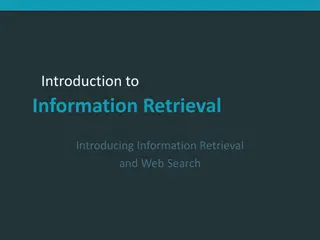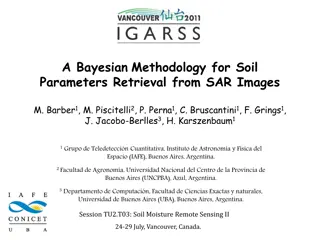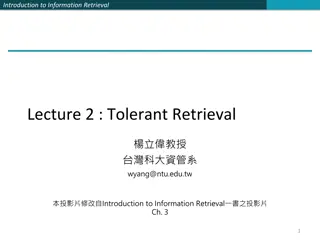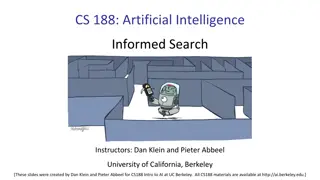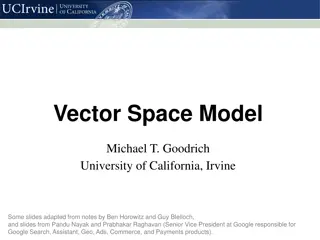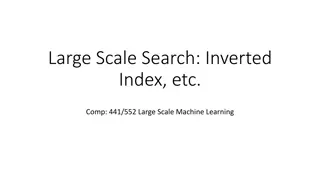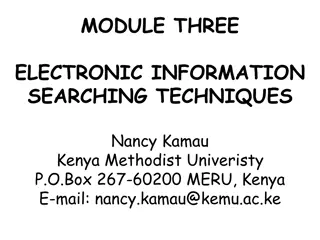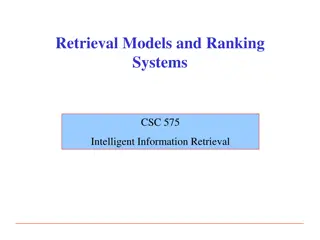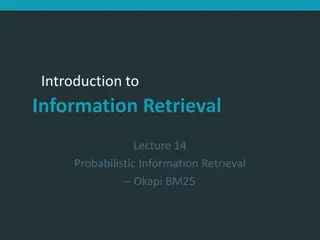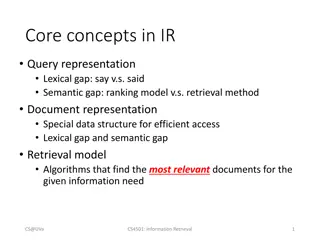Introduction to Information Retrieval and Web Search
Information Retrieval (IR) involves finding unstructured material, usually text documents, to satisfy information needs from large collections. This process is essential for various applications like web search, email search, and corporate knowledge bases. The evolution of unstructured vs. structured data is highlighted along with basic assumptions of information retrieval and the classic search model. Key concepts such as precision, recall, term-document incidence matrices, and handling unstructured data are discussed to illustrate the challenges and solutions in information retrieval.
Uploaded on Oct 02, 2024 | 0 Views
Download Presentation

Please find below an Image/Link to download the presentation.
The content on the website is provided AS IS for your information and personal use only. It may not be sold, licensed, or shared on other websites without obtaining consent from the author. Download presentation by click this link. If you encounter any issues during the download, it is possible that the publisher has removed the file from their server.
E N D
Presentation Transcript
Introduction to Information Retrieval Introducing Information Retrieval and Web Search
Information Retrieval Information Retrieval (IR) is finding material (usually documents) of an unstructured nature (usually text) that satisfies an information need from within large collections (usually stored on computers). These days we frequently think first of web search, but there are many other cases: E-mail search Searching your laptop Corporate knowledge bases Legal information retrieval 2
Unstructured (text) vs. structured (database) data in the mid-nineties Unstructured Structured Data volume Market Cap 3
Unstructured (text) vs. structured (database) data today Unstructured Structured Data volume Market Cap 4
Sec. 1.1 Basic assumptions of Information Retrieval Collection: A set of documents Assume it is a static collection for the moment Goal: Retrieve documents with information that is relevant to the user s information need and helps the user complete a task 5
The classic search model Get rid of mice in a polite correct way User task Misconception? Info about removing mice without killing them Info need Misformulation? Query how trap mice alive Search Search engine Query refinement Results Collection
Sec. 1.1 How good are the retrieved docs? Precision : Fraction of retrieved docs that are relevant to the user s information need Recall : Fraction of relevant docs in collection that are retrieved 7
Introduction to Information Retrieval Term-document incidence matrices
Sec. 1.1 Unstructured data in 1620 Which plays of Shakespeare contain the words Brutus ANDCaesar but NOTCalpurnia? One could grep all of Shakespeare s plays for Brutus and Caesar, then strip out lines containing Calpurnia? Why is that not the answer? Slow (for large corpora, linear scan not possible most of times) NOTCalpurnia is non-trivial Other operations (e.g., find the word Romans near countrymen) not feasible Ranked retrieval (best documents to return) 9
Sec. 1.1 Term-document incidence matrices Antony and Cleopatra Julius Caesar The Tempest Hamlet Othello Macbeth 1 1 0 0 0 1 Antony 1 1 0 1 0 0 Brutus 1 1 0 1 1 1 Caesar 0 1 0 0 0 0 Calpurnia 1 0 0 0 0 0 Cleopatra 1 0 1 1 1 1 mercy 1 0 1 1 1 0 worser 1 if play contains word, 0 otherwise BrutusANDCaesarBUTNOT Calpurnia
Sec. 1.1 Incidence vectors So we have a 0/1 vector for each term. To answer query: take the vectors for Brutus, Caesar and Calpurnia (complemented) bitwise AND. 110100 AND 110111 AND 101111 = 100100 Antony and Cleopatra Julius Caesar The Tempest Hamlet Othello Macbeth 1 1 0 0 0 1 Antony 1 1 0 1 0 0 Brutus 1 1 0 1 1 1 Caesar 0 1 0 0 0 0 Calpurnia 1 0 0 0 0 0 Cleopatra 1 0 1 1 1 1 mercy 1 0 1 1 1 0 worser 11
Sec. 1.1 Answers to query Antony and Cleopatra,Act III, Scene ii Agrippa [Aside to DOMITIUS ENOBARBUS]: Why, Enobarbus, When Antony found Julius Caesar dead, He cried almost to roaring; and he wept When at Philippi he found Brutus slain. Hamlet, Act III, Scene ii Lord Polonius: I did enact Julius Caesar I was killed i the Capitol; Brutus killed me. 12
Sec. 1.1 Bigger collections Consider N = 1 million documents, each with about 1000 words. Avg 6 bytes/word including spaces/punctuation 6GB of data in the documents. Say there are M = 500K distinct terms among these. 13
Sec. 1.1 Can t build the matrix 500K x 1M matrix has half-a-trillion 0 s and 1 s. But it has no more than one billion 1 s. matrix is extremely sparse. Why? What s a better representation? We only record the 1 positions. 14
Introduction to Information Retrieval Term-document incidence matrices
